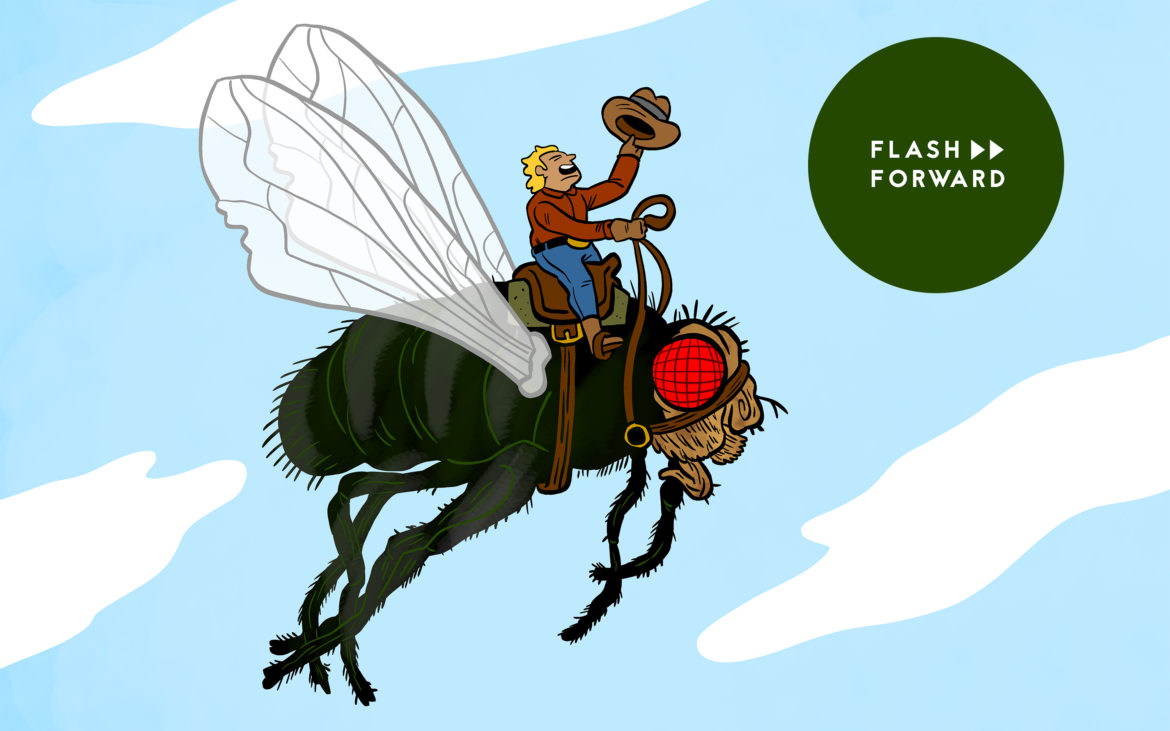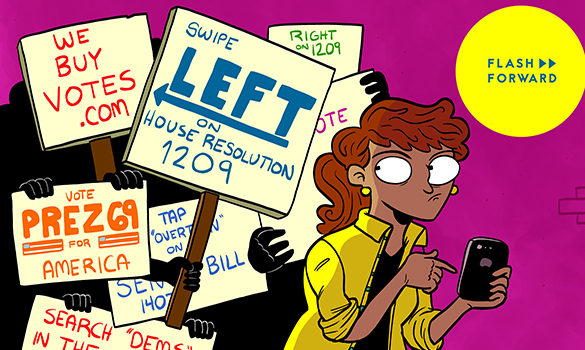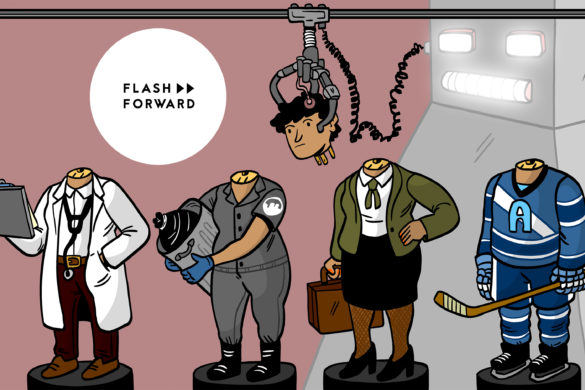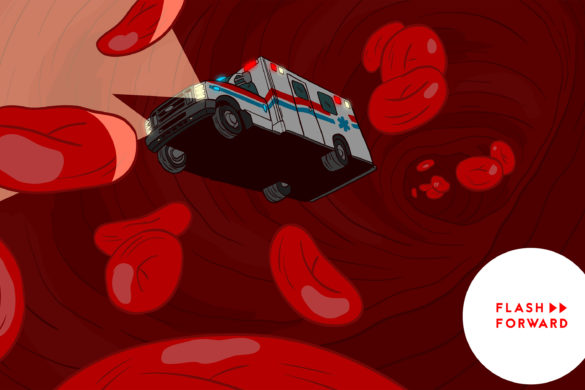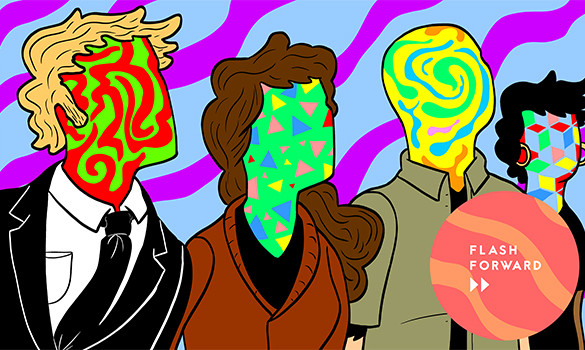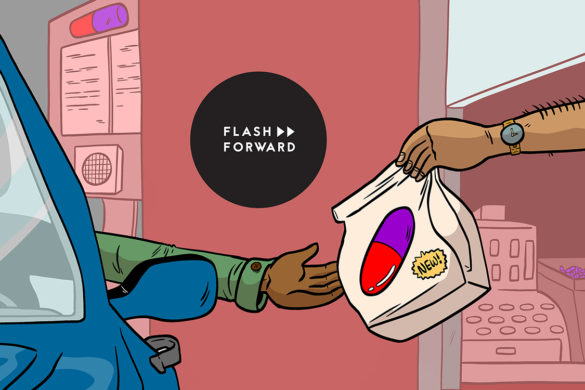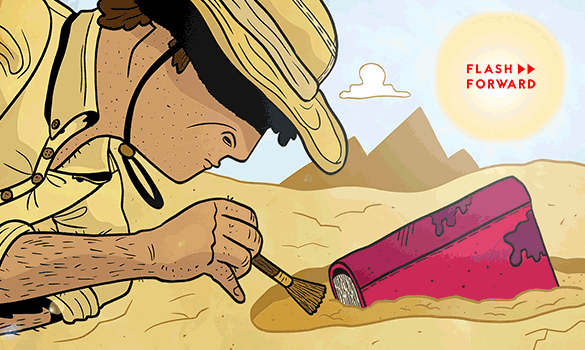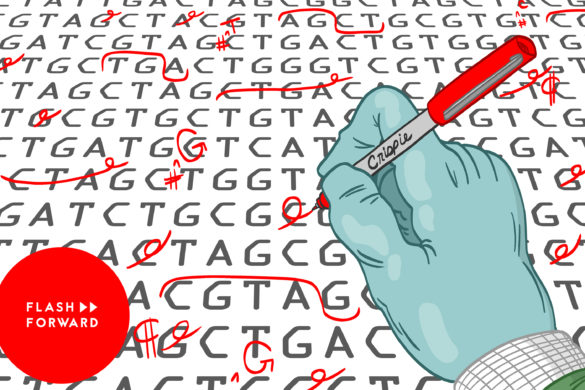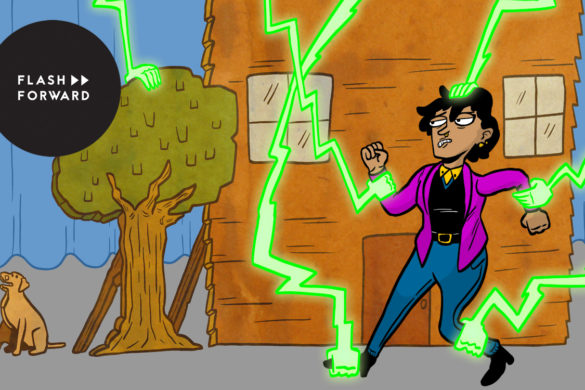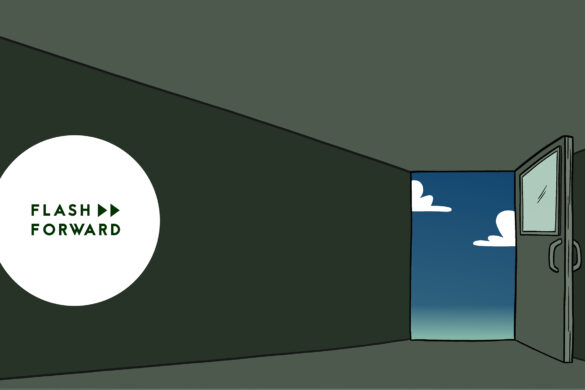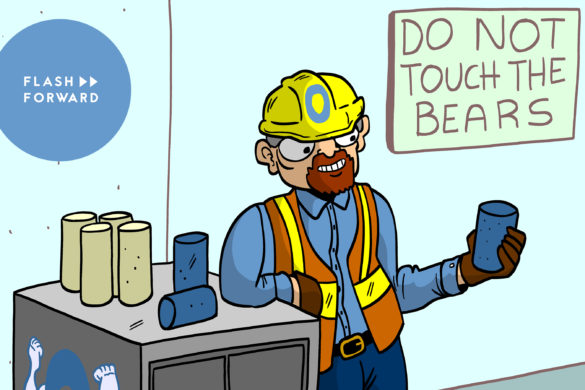Today’s episode is about a future where humans learn how to shrink ourselves. What are the ethics of making someone smaller against their will? Would we keep all our fingers and toes? Would we even be considered humans anymore?
Guests:
- Dr. Fei Chen, an assistant professor of stem cell and regenerative biology at Harvard.
- Dr. Jonathan Payne, a professor of geological sciences at Stanford.
- Dr. Sebastian Alvarado, an assistant professor of biology at Queens College, CUNY.
- Dr. Joyce Lee, a pediatric endocrinologist at the University of Michigan.
- Silvia Yee, a senior staff attorney at the Disability Rights Education & Defense Fund.
- Micah Perks, an author and director of creative writing at UC Santa Cruz.
Voice Actors:
- Parvus Employee #1: Henry Alexander Kelly
- Parvus Employee #2: Ashley Kellem
- Harry Purvis — Brett Tubbs
- Parvis Tour Guide — Chelsey B. Coombs
Further Reading:
- Honey, I Shrunk the Kids and the Science of Scale
- Team invents method to shrink objects to the nanoscale
- Expansion Microscopy
- 3D nanofabrication by volumetric deposition and controlled shrinkage of patterned scaffolds
- Stanford engineers’ new metamaterial doubles up on invisibility
- Energetic tradeoffs control the size distribution of aquatic mammals
- Body size downgrading of mammals over the late Quaternary
- The dynamic nature of DNA methylation: a role in response to social and seasonal variation
- Scientists shrink ants to study mechanisms that control DNA expression
- Epigenetic variation in the Egfr gene generates quantitative variation in a complex trait in ants
- Tall Girls: The Social Shaping of a Medical Therapy
- Using hormone treatment to reduce the adult height of tall girls: Are women satisfied with the decision in later years?
- Investigative Report Regarding the “Ashley Treatment”
- Modify the System, Not the Person
- The other story from a ‘Pillow Angel’
- 7 Dark Stories About Miniature People
Episode Sponsors:
- BetterHelp: Affordable, private online counseling. Anytime, anywhere. Flash Forward listeners: get 10% off your first month at betterhelp.com/flashforward
- BirdNote Daily: BirdNote Daily is a short, two-minute podcast that answers all of your burning bird-related questions — like, how do birds stay perched in a tree when they’re asleep? What’s the difference between a raven and crow? What’s the biggest bird that’s ever lived? Find our on Bird Note Daily, wherever you get your podcasts.
- Subscribe to American Hysteria on Apple Podcasts, Spotify, or wherever you get your podcasts.
Flash Forward is hosted by Rose Eveleth and produced by Julia Llinas Goodman. The intro music is by Asura and the outro music is by Hussalonia. The episode art is by Mattie Lubchansky. Amanda McLoughlin and Multitude Productions handle our ad sales. The voices from the future this episode were played by Chelsey B. Coombs, Ashley Kellem, Brett Tubbs and Henry Alexander Kelly.
If you want to suggest a future we should take on, send us a note on Twitter, Facebook or by email at info@flashforwardpod.com. We love hearing your ideas! And if you think you’ve spotted one of the little references I’ve hidden in the episode, email us there too. If you’re right, I’ll send you something cool.
And if you want to support the show, there are a few ways you can do that too! Head to www.flashforwardpod.com/support for more about how to give. But if that’s not in the cards for you, you can head to iTunes and leave us a nice review or just tell your friends about us. Those things really do help.
That’s all for this future, come back next time and we’ll travel to a new one.
FULL TRANSCRIPT BELOW
(transcripts provided by Emily White at The Wordary)
▹▹ ▹▹ ▹▹ ▹▹ ▹▹ ▹▹ ▹▹ ▹▹ ▹▹ ▹▹ ▹▹ ▹▹ ▹▹ ▹▹ ▹▹ ▹▹ ▹▹ ▹▹ ▹▹ ▹▹ ▹▹ ▹▹ ▹▹
FLASH FORWARD
S7E14 – “What If We Could Shrink Humans?”
[Flash Forward intro music – “Whispering Through” by Asura, an electronic, rhythm-heavy piece]
ROSE EVELETH:
Hello and welcome to Flash Forward! I’m Rose and I am your host. Flash Forward is a show about the future. Every episode, we take on a specific possible or, at least definitely in this case, in this episode, not-so-possible future scenario. We always start with a little bit of a field trip into the future to check out what is going on, and then we teleport back to today to talk to experts about how that world that we just heard might really go down, or, in fact, might not. Got it? Great!
This episode we are starting in the year 2073.
FICTION SKETCH BEGINS
EMPLOYEE 1:
Morning.
EMPLOYEE 2:
Hey.
EMPLOYEE 1:
You ready for this?
EMPLOYEE 2:
I don’t even know what this is.
EMPLOYEE 1:
(chuckles) Yeah, it’s probably going to be some sort of weird gimmick to get us to buy more Parvus products.
EMPLOYEE 2:
As if we could spend our Parvo-Bucks anywhere else…
TOUR GUIDE:
(commandingly, trying to get everyone’s attention) Good morning everyone! If you’ll follow me, we’re headed to the Norton Amphitheater at the end of the hall.
[footsteps down the hall]
EMPLOYEE 2:
You know, we could just leave right now.
EMPLOYEE 1:
I mean, it could be fun, right? I heard some of the engineers in Experiences are consulting on that new Jupiter Hotel.
EMPLOYEE 2:
Oh no, I am not going to space. You can go to Jupiter, I will stay right here on Earth where there’s gravity and solid ground, thank you very much.
EMPLOYEE 1:
Actually, I think Jupiter has more gravity than Earth, so…
EMPLOYEE 2:
Whatever. Are you coming with me or not?
[door handle jiggling]
EMPLOYEE 2:
Hey… This door wasn’t locked a minute ago. How did they do that?
EMPLOYEE 1:
It’s Parvus. There’s probably a tiny key bot inside the handle or something.
EMPLOYEE 2:
(sighs) Well, I guess we better go before they notice we’re missing.
[footsteps walking away]
TOUR GUIDE:
Welcome to Parvus Experiences! From the company that patented Self-Inserting Contact Lenses comes a new line of one-of-a-kind wellness and team-building experiences. Parvus is a leader in the health innovation space, and this latest venture is a natural extension of our core mission statement: Bigger Isn’t Always Better. Today, you are here thanks to one very special man. And I’m honored to say that he’s paying us a surprise visit!
[Harry Purvis comes out]
Please join me in welcoming Harry Purvis!
EMPLOYEE 1 (sarcastic):
Oh great.
Harry (magnanimous, clearly very excited):
My friends! Hello. I’m so excited to be able to pop in and say hello this morning. Ten years ago, I came to Parvus for the first time for a simple nano detox. And I’ll be honest, I was nervous. I really didn’t know what to expect. Sure, I had heard great things, but you and I both know that these kinds of detox techs can be… let’s say, hit and miss, shall we? (chuckles to himself)
(a little starry-eyed) But the moment that pod closed, and the experience started, I realized that this was, in fact, the real deal. My mind was cleared. My body was rejuvenated. I could see clearly my mission, my purpose. I could feel the potential that was inside me all along. It was like a door opening to endless possibilities, and that door had been inside of me all along.
I credit Parvus with at least 49% of my success. Can’t give them the full 50, otherwise they might ask for ownership. (laughs at his own bad joke) And ever since that day I’ve been a loyal customer, and now, owner of the company.
EMPLOYEE 2 (under their breath):Yeah… we know.
HARRY:
And of course, your lovely tour guide here was my first ever technician. She’s now a lead scientist at Parvus, so you’re all in good hands. I’m proud to offer the Parvus experience to all of our employees. And as a special show of gratitude to you, my most essential workers, I’ve set you up with a very, very special experience today. Not even my closest board members have gotten to try this out yet!
[looks at his watch]
Oh! Speaking of, can’t keep the board waiting. Off I go! Please, enjoy. And remember, it’s all about your perspective.
[helicopter starts up for Harry to board]
TOUR GUIDE:
(shouting) Thank you, Harry!
[helicopter fades away]
Now, I understand you all work for Parvus in the Custodial Engineering Department, is that right?
[silence]
You know, this experience will only be as valuable as the effort you put into it.
EMPLOYEE 1:
Um, yeah. We’re janitors.
TOUR GUIDE:
Excellent, excellent. Well, you’re all very lucky to be here today! In fact, this is the first-ever Parvus Retreat for Corporate Success – or PROCESSES (pricks), for short.
EMPLOYEE 2 (whispering):
They cannot be serious.
TOUR GUIDE:
If you could all make your way to the front of the room. Gather in close now, we want to minimize the distance you’ll have to travel later. I’m sure you all have a lot of questions, but everything will make much more sense once we… change our perspective!!
[whooshing and mysterious computerized bleeps and bloops]
EMPLOYEE 2:
What’s happening?!
EMPLOYEE 1:
Oh my god! Look, the chairs are growing!
[mysterious sounds get louder]
EMPLOYEE 2:
I knew I should’ve stayed home today!
TOUR GUIDE:
Everyone, please remain calm! You’ve all just been part of a momentous occasion – the first human subject trials of the Arriety Device, patent pending. Not to worry, you’ve all been implanted with a microchip – a micro-micro-chip, really – to monitor your vital signs. If everyone could please follow me…
[door opening, rustling]
As you can see, we find ourselves in Parvus Park. But though we’ve only traveled a few feet since you arrived, we might as well be in a totally different world. At this size, a blade of grass appears to us more like a stalk of corn. Stay close now, we wouldn’t want anyone to get lost!
[rustling noises]
Ah, notice how we can hear the movement of the grass.
EMPLOYEE 1:
What is that?!
TOUR GUIDE:
Does anyone have a guess?
[silence]
TOUR GUIDE:
Come on, now. Experimental evidence suggests that more engaged subjects experience much better outcomes!
EMPLOYEE 2:
It’s not a snake, is it?
TOUR GUIDE:
Not quite! It’s something even smaller —
[rustling gets louder]
— a common garden ant! Of course, at this size, it might remind us more of a large dog. But don’t worry, as long as we don’t get in its way, it’s completely harmless!
EMPLOYEE 2:
That does not look harmless to me.
TOUR GUIDE:
Now, for the real fun!
EMPLOYEE 2:
Oh, great.
TOUR GUIDE:
The amphitheater door has automatically locked behind us. There’s only one way for us to get back into Parvus headquarters at this size – the front door. It’s only a few blocks away, but at our current size, that will feel more like a 5-mile hike over rough terrain, with many obstacles in our way to be overcome. It’s 9am right now; the weather forecast predicts a thunderstorm around noon. We need to make it back inside before then if we want to avoid the possibility of death by drowning or hypothermia.
EMPLOYEE 2:
Okay no. You know what? No. Nope.
(calling to tour guide) Excuse me, I did not sign up for this!
TOUR GUIDE:
Actually, you did sign up for this. Experimental trials are part of your employment contract with Parvus.
EMPLOYEE 1:
HR did not mention that!
TOUR GUIDE:
Well, HR isn’t legally required to inform you of that contract provision. But I’m sure, if you looked the contract over with your attorney, that you noticed clause 14B includes a commitment to support all of Parvus’s scientific testing in mind, body, and spirit.
[ominous silence]
Now, then. Let’s begin.
[spooky electronic music crescendos and fades out]
FICTION SKETCH END
ROSE:
Okay, so today is a special episode for two reasons. First, it’s sort of a sibling episode to the last one we did where we talked about nanomedicine; super small technology that can be put inside a human body. Today, we are talking about something that is similar but a lot weirder, and that is making humans ourselves very tiny. And the second reason that this is a special episode is because this journey into making humans super small is brought to you by Julia Llinas Goodman. This idea came up a few months ago in conversation, and they were like, “But what if we just, like, shrunk humans?” And… That’s a great question. What if we just shrunk humans! So that is what we are going to talk about on this episode and Julia is going to take it from here.
JULIA LLINAS GOODMAN:
So, this is an idea that comes up a lot in science fiction. A bunch of the stories we talked about last week involve either a single person, or a group of people, getting shrunk down so that they can operate nanotechnology inside another person’s body. We’ve also talked on the show before about the idea of trying to make humans slightly smaller so we would use fewer resources and maybe have less of an impact on the planet.
But neither of these are actually why I, personally, am interested in this idea. See, there’s also a whole genre of these stories where the adventure doesn’t come so much from cutting-edge medicine or robotics, but instead from the everyday stuff all around us. Think of Alice in Wonderland, or Honey, I Shrunk the Kids – stories where regular people get super small, and suddenly, the everyday spaces all around them become totally unfamiliar. They’re forced to completely change their perspective on something they thought they understood.
During quarantine, most of us have been stuck in a pretty small amount of space; our homes, our local stores and parks, places we’re maybe too familiar with at this point. And so I got to thinking, since we couldn’t travel, what if we could change our perspective? What if there were a way for all of the normal, boring stuff around us to become totally new, and exciting, and maybe a little bit overwhelming? An adventure!
But in real life, we don’t have a way to take regular size stuff and just shrink it down to be super small. Or do we?
DR. FEI CHEN:
After we came out with this concept that you can, kind of, make something bigger, it’s kind of… there were some ideas about, “Oh, can you make things smaller with the same process?” which it turns out that you can.
JULIA:
This is Dr. Fei Chen, an assistant professor at Harvard. And like he said, he didn’t start by figuring out how to shrink things. He started out by making things bigger.
FEI:
We were particularly interested in looking at these things called synapses, which are, like, the connections between neurons in the brain, and they’re 100 nanometers or so. And so you couldn’t use normal light microscopes to look at them.
JULIA:
And it turns out, there are things too small to look at with a microscope. Specifically, Fei spends a lot of time looking at mouse brains.
FEI:
There’s this fundamental physical limit on how small you can magnify something with a microscope, a light microscope, that has to do with the wave nature of light.
JULIA:
Visible light has a wavelength of about 500 nanometers. Because of the way microscopes refract light, the smallest thing you can look at is about half that, around 200 nanometers, at the most. Synapses are less than half that size.
FEI:
Obviously, then there’s other approaches, like there’s electron microscopy, which goes beyond that limit, not by using light. They’re these images that are, like, black and white, but they have like this ridiculous, you know, resolution.
JULIA:
But electron microscopes are expensive. Like, a thousand times more expensive than regular ones.
FEI:
And so we decided that maybe instead of making better microscopes, we could make the sample itself bigger.
JULIA:
And to do that, they used a material called hydrogel.
FEI:
Actually, this stuff has been around for a long time. They’re used in, like, baby diapers and these other things. But it has this interesting property which, when you put it in water, it swells a lot, like up to like a thousand times in volume. I don’t know if you’ve seen, like, those grow dinosaurs; it’s the same material that’s in those.
JULIA:
So Fei’s team stuck the slices of mouse brain they wanted to look at into the hydrogel. And for this whole thing to work, they had to attach the sample to the gel in a way that would let everything expand together.
FEI:
We did a lot of, like, chemistry and all this other stuff to make it such that the expansion was very uniform in each direction so we could preserve… like, if you want to look at a really small thing, we want to preserve the relative locations of all the things that we’re looking at, right?
JULIA:
Then they added water. And both the gel and the samples inside got about five times bigger. This process was also reversible. So if you wanted to store the samples at a smaller size, you could shrink the hydrogel down and the sample would shrink too.
FEI:
So you can imagine, like, a net, right? When you expand it, you make the net… you, like, stretch out the net so that all of the grids are, like, fully stretched out. And then when you shrink it, what’s happening is that each polymer, or each grid, is actually getting, like, really squished up and compacted.
JULIA:
This technique isn’t limited to organic things. Fei also helped develop a similar process that can be used on other materials. It’s called ‘implosion fabrication’.
FEI:
You can take, like, a laser and draw… like, use the laser, and the laser can basically go in and draw inside of this expanded hydrogel the patterns that you want. And then when you shrink it back down, you’re effectively shrinking the size of the features that you drew.
JULIA:
There are some limits. Each material needs its own specific process to attach to the hydrogel so it can shrink properly. We can’t shrink any random object just yet. But there are still a lot of exciting applications of this technology.
FEI:
You can make a very cool… what are called optical metamaterials. But all they are is, they’re materials that interact with light in ways that you can’t have with just glass. And the thing that always comes up with… like, the sci-fi-esque thing for metamaterials is invisibility cloaking devices. You can make metamaterials in a way such that they can pass light around them, and when you look at them from certain angles, it looks like the scene behind it. There are lots of uses for these sorts of materials and they’re hard to make because they require printing of these very fine features.
JULIA:
But this episode is not about invisibility cloaks; we’ve already done that one. It’s about shrinking humans. So I had to ask Fei, is there any way we could use this on a living animal?
FEI:
I don’t think you could do it in a way that kept it alive.
JULIA:
There are obviously… a few reasons for that. But one of the big ones Fei mentioned is this physical property we talked about last episode; the surface-area-to-volume ratio. It’s the same thing that gives nanomaterials their special properties. As things get smaller, their volume decreases faster than their surface area.
FEI:
It becomes very important in a lot of different things because the volume dictates the concentration of whatever that’s in your cell, perhaps. And the surface area often dictates, like, the interactions between one cell and another.
JULIA:
And this isn’t just an issue at the cellular level.
DR. JONATHAN PAYNE:
You lose heat related to your surface area. And so as you get small, you have a lot of relative surface area, which means that if you’re trying to stay warm, you lose that heat to the environment more quickly.
JULIA:
This is Dr. Jonathan Payne, a Professor of Geological Sciences at Stanford.
JONATHAN:
This is an explanation for why you don’t have mouse-sized marine mammals. Essentially, it would be very, very difficult for them to insulate themselves well enough to be mouse-sized in the ocean. Sea otter size is about as small as you could be unless you had massively effective insulation.
JULIA:
So if we got really small, we’d have to figure out a way to keep ourselves warm. And maybe you saw this coming, but that’s really not the only problem here. There are a whole bunch of things about our bodies that are tied to being this specific size.
JONATHAN:
Body size correlates with a lot of different traits for any organism. It correlates with how long you live, how you transport material within your body or your cell, it correlates with how you reproduce.
JULIA:
Jonathan studies how different environmental factors can affect animal size. For example, temperature.
JONATHAN:
That’s a pattern that generally shows up geographically in the modern world, that in many groups of mammals within species, the individuals tend to be a bit larger in colder areas and smaller in warmer areas.
JULIA:
By the way, when Jonathan says “the modern world,” he means that in evolutionary terms – the last 100,000 years or so. So it’s possible that as the world gets hotter, humans could start naturally adjusting to be smaller. But we’re not talking about shrinking ourselves in hydrogel here. That process involves evolution and might also take a really long time.
Shrinking someone over their individual lifetime would be a lot harder. But there are factors that can have a faster impact on an animal’s size.
DR. SEBASTIÁN ALVARADO:
So if we’re talking about humans, we’re talking about how well we feed them and the nutrients we give them in the first 12-13 years of their life, because that’s where all these growth changes are really happening.
JULIA:
This is Dr. Sebastián Alvarado, an assistant professor at Queens College with the City University of New York. He also researches how environmental factors impact animals’ bodies, but on a much shorter timescale.
SEBASTIÁN:
When I did my PhD, or when I was selecting a PhD advisor, I had found a very interesting story that was recently published about how maternal behavior could affect the way genes are regulated in the brain. And for me, that sounded a lot like how the X-Men awaken their powers when they go through some sort of traumatic event, and genes aren’t these static objects, but they are these very dynamic things that change with all kinds of experiences.
JULIA:
There are lots of things we might be able to tweak to change the size of an animal.
SEBASTIÁN:
Something like fish in a tank. If you make them really crowded, there’s going to be an upper limit of their size just due to the resources available. And that would be one way to shrink things.
JULIA:
Sebastián studies how exactly these living conditions are able to influence animals’ bodies. One of the key ways is a process called DNA methylation.
SEBASTIÁN:
DNA methylation is a modification that gets made to one of the building blocks of DNA. And what’s really interesting about it is that it has a function; it often acts like a molecular off switch to a gene if it’s situated just before that gene starts.
What’s really cool about it is that it’s reversible. You can add methylation and you can remove it as well. And there are all kinds of environmental triggers that can lead to the removal or the addition of methylation to very specific genes in very specific tissues.
JULIA:
When our lifestyle or environment changes, it can literally change our DNA. But Sebastián also wanted to know if it was possible to trigger these types of changes artificially. Specifically, in ants.
SEBASTIÁN:
We found that these workers that were of the minors, so the smaller ones, had much more DNA methylation across all of their organism compared to major workers, which are these soldier group of individuals.
JULIA:
So, if you just look at the genetic material of one of these smaller ants, you’ll see that it has a lot of methylation. The question is, does the methylation cause the smaller size, or are they just correlated? If you had chemicals that could add or remove DNA methylation, would that change the size of the ants?
Well, Sebastián did have those chemicals, so he tried it. And… it worked!
SEBASTIÁN:
We found that those that emerged after being treated with this methylation enhancer were actually smaller compared to controls, and those that were treated with the methylation inhibitor were actually larger than the controls.
JULIA:
And this wasn’t just, like, a tiny, imperceptible size difference.
JULIA:
Okay, so this is huge news for the idea of shrinking humans. We literally already have done this with ants!
Of course, it’s not going to be quite that easy. First of all, there are just a few differences between humans and ants. Also, somebiological changes can be switched back and forth, but others can’t.
SEBASTIÁN:
When it comes to things like growth. I’m imagining bones, muscle tissue, all these things. It’s hard to go back on how a bone becomes this solid tissue that… it’s kind of unchangeable. It needs to be because it’s supporting your body, and its weight, and all those other things.
Things like muscle growth, working out, these are things that have more plasticity. You can grow a new muscle, you can grow new skin. So these are things that, perhaps, affecting these tissues is a little bit more accessible than perhaps bone or your size. But as far as your skeletal structure, that’s going to be a little bit more difficult to go back on.
JULIA:
We couldn’t use this process to just grow and shrink ourselves at will. At least right now, these would be more permanent body size changes. More like the story we talked about last week where the scientist shrinks his assistant and then admits he doesn’t know how to reverse the process.
SEBASTIÁN:
However, I would say that if you are, hypothetically, on a separate planet or in an environment where you can control absolutely everything, you most definitely probably could control the developmental trajectory and the chemical and physical cues that lead to size variation.
JULIA:
For the ants, Sebastián specifically added the chemicals while they were in the larval stage, when most ant growth happens. For humans, the equivalent would have to be sometime before the early teenage years; that’s when most of our height growth happens.
But the idea of changing our bodies that young, brings us to some of the major ethical issues at play here.
SILVIA YEE:
I do think there is a slippery slope here. Then we really are looking at, well, lots and lots of potential changes that are easier for the people around us and not necessarily better for the person who is undergoing the changes.
JULIA:
And that’s what we’re going to talk about when we come back.
ADVERTISEMENT: BIRDNOTE
Today’s episode is supported in part by BirdNote.
BirdNote Daily is a short, two-minute podcast that answers all of your burning, bird-related questions. And I know, listeners; I know that you have them. For example, how do birds stay perched in a tree when they are asleep? That’s actually a question I didn’t realize I had until I had to read this advertisement. And then I was like, “Wait? How do birds sleep upright and not fall over?” What is the difference between a raven and a crow? What is the biggest bird that has ever lived?
Right now, they are exploring the wonders of bird migration. And let me tell you, some of the stuff in these episodes is really wild. Like for example, some songbirds will consume their own organs for energy on their long flights. Indigo buntings have proteins in their eyes that let them see magnetic fields. And the veery, which is a kind of thrush – and if you don’t know what a thrush is, you should listen to BirdNote Daily and you will learn – the veery will predict hurricanes, sometimes better than computer models do.
You can hear all about that and more on BirdNote Daily. Get it wherever you get your podcasts, or at BirdNote.org.
ADVERTISEMENT END
ADVERTISEMENT: AMERICAN HYSTERIA
I also want to tell you about another podcast that I think Flash Forward listeners might enjoy. It’s called American Hysteria, and it’s a podcast that explores moral panics, conspiracy theories, urban legends, and fantastical thinking, and how they have shaped American culture and politics from the Puritans to the present. The show has covered topics ranging from poisoned Halloween candy (which is actually one of my favorite episodes), mind control (which we have talked about on Flash Forward as well), phantom clowns, satanic cults, the Illuminati, the gay agenda, true crime, televangelists, and so much more.
Host Chelsey Weber-Smith takes you down strange, and often uniquely American, wormholes presenting forgotten oddities of history and popular culture, plus some really interesting analysis that shows you what we can actually learn from these stories. Sometimes horrifying, sometimes hilarious, sometimes heartfelt, American Hysteria seeks to understand why humans fear the wrong things and believe in these false realities, and what these distractions are really covering up.
It might not seem like this is a show about the future, but it actually really does help to understand how we wind up on the wrong path and maybe a little bit about how to prevent that in the future.
So subscribe to American Hysteria now wherever you get your podcasts.
ADVERTISEMENT END
JULIA:
If making humans smaller sounds like science fiction to you, then you might be surprised to hear that it’s actually been happening for decades.
DR. JOYCE LEE:
So typically, girls were around 9 to 16 years of age, so on average they were around 12 or 13, and… we all have growth plates, right? And if you give estrogen early on, you essentially are fusing those growth plates and you are reducing, you know, potential for future height for those individuals.
JULIA:
This is Dr. Joyce Lee, a pediatric endocrinologist at the University of Michigan.
In the 1940s, doctors realized that hormones during puberty triggered the end of bone growth in human bodies. There’s a reason why we don’t just keep growing forever, right? In particular, estrogen seemed to be one of the main actors here. It looked like when kids had more estrogen, they ended up being shorter.
So doctors actually started giving certain kids estrogen to keep them short. You might be wondering, why would people want to do something like this?
JOYCE:
The reasons included parents who were concerned about the social implications of their daughters being too tall, difficulty and expense in finding clothes that fit, lack of interest in schoolwork and play. The single most commonly cited social reason for reducing height of tall girls was social attractiveness. They were worried that tall stature would contribute to their daughter’s self-consciousness and shyness or that her size might jeopardize her social contacts. Like, parents were worried that if their girls were too tall, they would not find a husband and they would not get married.
JULIA:
You probably noticed that Joyce didn’t mention boys here. Because this was pretty much only done to girls. And there were a lot of side effects.
JOYCE:
Nausea, headaches, weight gain, breakthrough bleeding, ovarian cysts, rare cases of thromboembolism or clots. When they use the estrogens, they use them at such high doses that… these are doses now that would not be considered safe for administration because of… I mean, there’s risk of clotting and other things because the doses were so much higher and, like, the side effects of the therapy were not really known. The amount of estrogen you’ll see in, like, a typical oral contraceptive pill is nowhere near what the doses were when those girls were being treated way back when for tall stature.
JULIA:
These treatments consisted of up to 400 times the amount of hormones in today’s typical birth control pill. Later studies found that some of the medications used could reduce fertility and cause cancer.
I feel like we have to pause here to emphasize how absolutely wild this is. Young girls were given huge doses of hormones, mostly so they wouldn’t get too tall to be attractive to a man? What?! And this wasn’t just, like, one weird doctor doing this. This happened to thousands of women across the United States, Australia, and Europe.
Meanwhile, the actual impact on height was questionable, at best. Doctors at the time reported that girls given this treatment stayed 2-4 inches shorter than their predicted height. But because height predictions are imperfect and there were very few controlled trials, it’s hard to know how effective it actually was.
The supposed benefit was that girls would fit in better, have more friends, feel happier about their bodies. But that didn’t really happen.
JOYCE:
So there was a study that looked at women who were evaluated for tall stature and about half of them were treated with estrogen therapy and then about half of them were left untreated. So, they did do a study to look at their psychosocial outcomes, and they apparently had similarly poor psychosocial outcomes in terms of depression, eating disorders. There did not seem to be any psychosocial benefit of the treatment. But what’s really interesting is that about 99% of the untreated women were glad that they were never treated with the estrogen, whereas 42% of the treated women were dissatisfied with the decision that was made about estrogen treatment.
JULIA:
Regardless of whether or not girls received the treatment, one of the main factors correlated with later depression was whether they felt like they got to make the decision themselves. Women who said they had an active say in their treatment decision were significantly less likely to experience depression.
This gets at one of the key ethical issues with changing human size. Even if we do have a foolproof way of shrinking people, should we? And who gets to make that decision?
SILVIA:
I do think there is a slippery slope here. I mean, there can be lots of times or ways in which it would be more convenient to have a child who is more controllable, who is easier to transport, who is not going to panic with changes in their body or getting their menstrual periods. I mean, there’s such a spectrum of personalities, of needs, of intellectual understanding, of physical capacity, and I just think that if we don’t recognize that there is an integrity to human beings as… then we really are looking at, well, lots and lots of potential changes that are easier for the people around us and not necessarily better for the person who is undergoing the changes.
JULIA:
This is Silvia Yee, a senior staff attorney with the Disability Rights Education and Defense Fund.
In October of 2006, two doctors published a paper about procedures they’d done on a 6-year-old girl named Ashley.
SILVIA:
And it was called health care treatment, but it was invasive procedures designed to reduce her growth. A hysterectomy, removal of her breast buds, just various interventions that were not medically needed. They weren’t needed to help her survive, let’s say, and they weren’t… It was arguable that they were needed to help her have a higher quality of life. I mean, I think that’s sort of the crux of it.
JULIA:
The treatment also included high doses of estrogen to end Ashley’s growth. Her final height ended up at 4’5″.
Ashley’s parents, who chose to remain anonymous, said that they pursued the treatment to improve their daughter’s quality of life. Ashley has a disability that means she can’t speak or move by herself, so they hoped her small size would allow them to carry her more places. But they don’t have a way of communicating with her or asking her what she wants.
And Silvia says this is one of the problems with the way this treatment was done. In Ashley’s case, the hospital and the parents made the decision without any outside oversight.
SILVIA:
First of all, it should be something that is not just a decision made between a family and their doctor. Since a person with disabilities, and presumably with developmental and intellectual disabilities, is involved, there needs to be more transparency and more safeguards around the administration of these surgeries and this kind of growth attenuation.
And then second, that whoever is an ultimate decision-maker in this should have some education and awareness of the other side; that it isn’t just a matter of, like, “Well, the parents really want this, so it should be okay.
JULIA:
The hospital later admitted that it broke the law by failing to get a court’s permission for some of the procedures.
It’s unclear how many other disabled kids have received these types of treatments. But after news broke of Ashley’s story, the National Disability Rights Network estimated that thousands of parents were actively exploring the idea.
Even if hospitals do get all the legal permissions needed, Silvia says this still raises a deeper issue about who gets to change a person’s body, and why.
SILVIA:
In the medical world in particular, people with disabilities are regarded through a medical lens, primarily through their diagnosis. Your potential as a person, the quality of life you have, what you’re going to be able to do, how long you will live, what you need, is often decided through the label of your diagnosis.
So for people with disabilities, they’re always trying to push the social model; that it’s not just my diagnosis, it’s the interaction with the world. If I have sufficient services, and supports, and opportunities, that level playing field, you have no idea what I can do because I’ve never been given that yet.
JULIA:
This is something Joyce brought up, too. Giving tall girls hormones to keep them short isn’t common anymore, but not just for medical reasons. There are social factors here, too.
JOYCE:
And what’s really fascinating is what the threshold of treatment was for tall stature and how that changed over time. So, when physicians were asked “how tall is too tall for a girl,” in the mid-‘60s it was around 5’8″. That might be the threshold at which they would want to treat. But that rose to 5’10” in the late ‘60s, and then close to 6′ in the late ‘70s.
JULIA:
This treatment didn’t fall out of favor because women don’t get tall anymore. The definition of “tall” changed. And so did the definition of womanhood.
JOYCE:
The primary purpose of women is no longer to get married, right? I mean, I would say that those sort of forces probably exist currently, but I would say that there’s probably more openness to this notion that girls are independent beings who have the ability to choose what they want to do with their life. It’s more acceptable, right? It’s okay to be 5’9″ and be a girl. It’s actually an advantage if there are certain things that you want to pursue in life.
JULIA:
If the world is too hard to live in for tall women, we probably need to change the world… not women’s bodies. And we could say the same thing if the world is too hard to live in for disabled children and their parents.
SILVIA:
Those of us who have kids without disabilities are going to face kids who don’t necessarily want to do what you want them to do, who are going to make all kinds of choices that put them in dangerous situations or put them at risk in some way. And we know that, and we try to prepare our children for that. I don’t think that fundamentally changes for a parent of a child with disabilities. You take them as they are and you try to prepare them as much as possible to be in the world, to fully be in the world, with all their abilities, and disabilities, and capacities, and dreams. And along the way, if you have the energy for it, you try to change the world a little bit too so your child can live in it, right? Can actually thrive in it.
JULIA:
So let’s say we could make people tiny. Sure, some people might just decide to do it themselves.
SILVIA:
But then you’re going to get two more things. You’re going to get a norm because people are going to think that’s a good thing or that’s a bad thing for all these reasons. And you’re also going to get, inevitably, corporate profit motives being brought in. Really, I don’t think we’re in a world where people just get to make the best decisions for themselves without influence. I think there’s always tons and tons of influence.
Inevitably, someone will discover this process, and it will be patented, if it’s possible, because we’re in a world that allows that. And someone or some people will make more money from this than others. And who they want to market to and how they’ll market it is going to influence individual decisions. We see that in, like, pre-genetic testing, let’s say. We see that in lots of examples already where, like, who is selling what to whom?
JULIA:
I still think it would be really cool to be ant-sized, as long as it was reversible. But all of this made me realize that it’s really important to have safeguards to make sure people aren’t forced into doing this. It’s honestly not hard for me to imagine that if we had this technology, it would end up a lot like our opening scene.
But, just for fun, I want to think about what this could look like if we sorted out all of the ethical issues. Why are there so many science fiction stories about people shrinking? And what might the world be like if some of us decided to actually try it?
JONATHAN:
You know, “would you still call those humans,” I think, is actually a reasonable question. You know, what would you be able to talk about with that human? I’m not sure.
JULIA:
More on that, when we come back.
ADVERTISEMENT: BETTERHELP
This podcast is sponsored by BetterHelp.
Is there something interfering with your happiness or preventing you from achieving your goals? We all have places where we feel stuck, or confused, and could just use someone to talk to. Sometimes we don’t even really know, like, how to name the thing that is standing in the way, or what exactly is stuck, but we just sort of know it’s there.
That is where BetterHelp comes in. BetterHelp will assess your needs and match you with your own licensed, professional therapist who you can start communicating with in under 48 hours. It’s not a crisis line, it’s not self-help; it is professional therapy done securely online. You can log into your account anytime and send a message to your therapist. You’ll get timely and thoughtful responses, plus you can schedule weekly video or phone sessions.
BetterHelp is also really committed to facilitating great therapeutic matches, so they make it easy and free to change therapists if you need. Visit BetterHelp.com/FlashForward to join the over 2 million people who have taken charge of their mental health with the help of an experienced professional. Plus, there is a special offer for Flash Forward listeners. You can get 10% off your first month at BetterHelp.com/FlashForward.
ADVERTISEMENT END
JULIA:
Okay, so we’ve talked about how we could shrink humans, we’ve talked about why we might or might not want to do that. Now let’s talk about what it would actually be like if we did.
JONATHAN:
As animals get very small, they need to adapt in different ways. One of the things, for example, that scales with body size is the rate of your heartbeat. So, if you look at very small birds, for example, and mammals, their heart rates go up as they get smaller in terms of beats per minute.
JULIA:
That’s Dr. Jonathan Payne again. There are a whole bunch of basic bodily processes that can look really different based on your size. Like, smaller animals are more likely to have what’s called an open circulatory system.
JONATHAN:
When we pump our blood, we pump it through arteries. It goes through a capillary network and then it comes back into the heart through veins, and it never spills out anywhere. And so it’s moving very efficiently and very much in one direction. In an open circulatory system, you’re more spraying those kinds of fluids onto your internal organs to bathe them in fluid for gas exchange and, you know, other metabolic needs.
JULIA:
To be clear, this isn’t a simple, one-to-one relationship. Having a closed circulatory system made it easier for some animals to evolve to larger sizes. That doesn’t mean animals that evolve to be smaller will automatically lose their veins and arteries.
But it does seem to work that way sometimes. For example, with this type of tiny crustacean called an ostracod.
JONATHAN:
Many of the early ostracods were actually, you know, moderately big, so, say a centimeter-ish in size. And they had lots of internal anatomy, circulatory systems, things like this. They dropped quite a bit of that when they evolved to become millimeter-scale size, or even sub-millimeter, which is where most of them are now. At that point, you become so small that you can get by on diffusion for a lot of the things that you do. And so, you don’t need all of the internal organs that a larger animal needs to do its work.
JULIA:
So, if we spend enough time at millimeter size, we could lose our lungs. But it’ll be okay because we won’t need them! There may also be some more… visible changes.
JONATHAN:
It would be unlikely that our bodies would look exactly the way they do now. One of the other places that shows up is in terms of bones and muscles. The strength of your bones and muscles is related to their cross-sectional area. But the amount of mass that they need to be able to move around or support is related to your volume. And so as you get smaller, it’s actually much easier to have very thin limbs.
JULIA:
If humans got a lot smaller, we’d have to be prepared for things to get pretty weird.
JONATHAN:
The very smallest amphibians often start to lose digits. So, you know, we have in our bodies, typically five fingers and five toes on each hand, and that’s typical of most vertebrate species on land. The very, very small ones often start to lose these digits. And it appears basically that they’re getting so small that having digits at that size doesn’t really do anything. And so there’s no more selective pressure to maintain the development of those digits, and so they lose them in fairly random ways.
JULIA:
Some of these biological changes could also have a pretty big impact on our society and culture.
JONATHAN:
In mammals, and in most other animals, body size correlates a lot with lifespan. Humans benefit a lot from living a long time, and we learn for several decades before we’re more or less independent in modern societies. If you’re mouse size, you probably only live for a couple of years. Can you fit all of that training to create something that acts like a modern human into just a year or two of development? My guess is, probably not.
JULIA:
Being tiny might require us to completely rethink our educational system, our family structures… not to mention the literal spaces we live in.
MICAH PERKS:
I think we have to live, maybe, underground or up in trees. I think, you know, the way tiny animals often live, you know, like burrowing into burrows or hiding up in nests because there’s a lot of things that happen on the ground with predators.
JULIA:
This is Micah Perks, an author and Director of Creative Writing at the University of California, Santa Cruz. She’s been interested in stories about tiny people ever since she was a kid.
MICAH:
The books about tiny people that are children’s books are often about how fun it is that they repurpose giant human things to tiny sizes; they use a needle for a sword or a matchbox for a bed.
JULIA:
There’s something about that difference, the relationship between the giant and the tiny, that can be really compelling. Writer C.S. Lewis, for example, said that his first experience of beauty was looking at a miniature garden his brother made in a biscuit tin.
MICAH:
He writes in his memoir that the first time, he calls it numinousness, but really the first time he had the feeling of the sacred, or of God, was looking at this just tiny little world that his brother had made out of moss, and sticks, and whatever and that something about it… Yes, it has some kind of magical, numinous feeling to us to see something tiny.
JULIA:
At the same time, stories about the very small can also be incredibly creepy. When this concept comes up in adult fiction, the stories are often a lot darker.
MICAH:
There’s a more… It’s much more about a kind of anxiety-provoking power differential, often. And so, tiny people, then their strength is that they can disappear and hide. But also their challenge is that they can be tortured and treated really badly because they’re not strong.
JULIA:
Most of these stories include both people of the size we’re used to and super-small people.
MICAH:
I mean, some of the stories… like I’m thinking about the Aimee Bender story about a big man and a little man, and the big man has a little man for a pet and then begins torturing the little man. Very unsettling story, and the story wouldn’t even make any sense without the big man because the big people are often the threats to the little people.
JULIA:
And there’s another kind of mind-bending idea that these stories raise, which is: aren’t humans actually already tiny? I mean, in the grand scheme of things…
MICAH:
We’re little, right? I mean, we are tiny little people living on a tiny little planet in a giant universe.
JULIA:
And maybe this is part of why there are so many stories about people shrinking. It gets at that feeling of how we ourselves, as humans, actually are tiny. Compared to the universe and even just our planet.
MICAH:
It’s kind of the same feeling we have when we see something tremendous like, say, a giant waterfall or something. We have that feeling of the sublime, like… you know, that feeling of transcendence.
JULIA:
Micah also compared it to the feeling we might get from reading a really good poem.
MICAH:
A poem is this very compressed form of language, right? And so, we love poetry because it compresses meaning and image, and we’re down to this tincture, you know, like alcohol, liquor, or something like that. And so, a tiny person is this condensed, compressed human being. And so its intensity is in a very small place. So it’s very intense.
And you can imagine that the dangers, the passions, all of it is very intense for them. I mean, I would imagine, too, that for the tiny beings on our planet, life is probably much more intense than it is for us, both because of the stakes, the dangers, but maybe even their joys are more intense than ours are. We can only imagine.
JULIA:
Which can be terrifying, but it can also be captivating. I mean, I can’t even count how many movies, and books, and TV shows I’ve encountered that involve some version of this idea. Sebastián also had a theory I liked about why shrinking stories are so popular.
SEBASTIÁN:
I obviously have my biases, but I think it’s like a crash course in what it’s like to be a scientist because you get to see things that nobody else gets to see. It’s the sense of discovery. You’re seeing a space and something that you don’t normally see the same way. It’s like when… perhaps you may remember, there was this movie called Honey, I Shrunk the Kids, and there’s this awe that comes from seeing the exact same thing that you’ve seen every day for your whole life, which is just your lawn, right? And then now, all of a sudden, your lawn is alive. And it’s not just the lawn, but it has ants that you can… that become your pet, because they made a pet out of one of the ants in the movie.
But like, there are stories to be told at a different point of view, and that whole idea that you can tell a story that you wouldn’t otherwise see without that change in scale. And I think, as humans, we’re innately curious and excited about things that we don’t understand yet.
JULIA:
Sure, science is usually about answering very specific questions, with very specific data.
JONATHAN:
But the reason we do science isn’t always about that. You know, it’s often about the… what seemed like crazier questions, right? What seemed like science fiction when we started and eventually don’t seem so crazy at all.
JULIA:
We can’t actually shrink humans, and honestly, I’m not even really sure we should try. But fictional tiny people could still have something important to tell us about how we live today.
JONATHAN:
I think that our ability to engineer biological systems is increasing enormously. I think I read this morning that, you know, there was just a transplant of a kidney that was grown inside of a pig into a human. So, you know, we can do things with bodies that would have seemed like science fiction 50 or 100 years ago. And so, I don’t think that it’s crazy to be asking questions about what might we be able to do with bodies in 50 or 100 years that we can’t imagine doing right now.
[Flash Forward closing music begins – a snapping, synthy piece]
Flash Forward was created by me, Rose Eveleth. This episode was reported, produced, and hosted by Julia Llinas Goodman. The intro music is by Asura and the outro music is by Hussalonia. The episode art is by Mattie Lubchansky. The voices from the future this episode were played by Chelsey B. Coombs, Ashley Kellem, Brett Tubbs, and Henry Alexander Kelly. You can find out more about all of them in the show notes. Please do check out their work. They are amazing.
If you think you’ve spotted one of the little references that Julia and I have hidden in this episode, you can email us at Info@FlashForwardPod.com. If you are right, we will send you something cool. And if you want to discuss this episode, or some other episode, or just the future in general, or whether or not this discussion should be happening at all on Facebook, you can join the Facebook group. Just search ‘Flash Forward Podcast’ and ask to join and you can find a long conversation about whether or not we should leave Facebook.
So feel free to join and voice your concerns or email me and let me know if you would like to be in some sort of group to discuss the show but you aren’t on Facebook and you’d rather something else. And ideally, you’d tell me what that other thing is, like a Discord, or a Slack, or something else. Just let me know. Info@FlashForwardPod.com
If you want to support the show, there are a couple of ways that you can do that as well. You can head to FlashForwardPod.com/Support for more about how to give. But if that is not in the cards for you, you can head to Apple Podcasts and leave a nice review. Those reviews genuinely really do help. Or you can just tell your friends about the show. That also is a huge help.
That’s all for this future. Come back next time and we’ll travel to a new one. And in fact, the next episode that you hear is going to be special, for a variety of reasons, and I won’t spoil them all. But the next episode that you hear is going to be the first in our four-part season finale, so I hope that you’re excited.
[music fades out]

